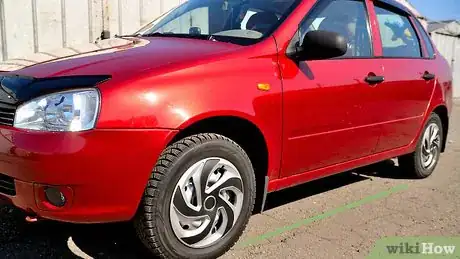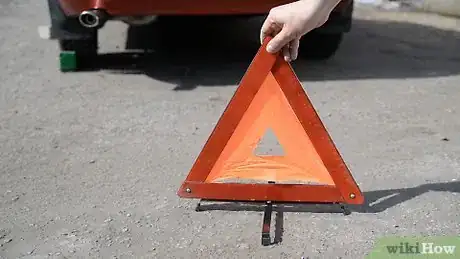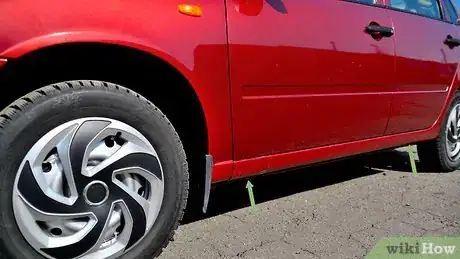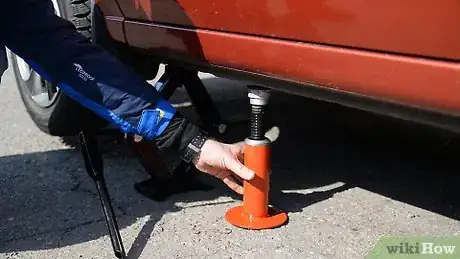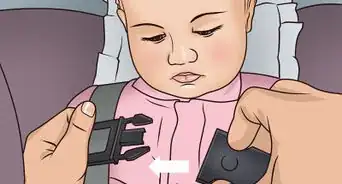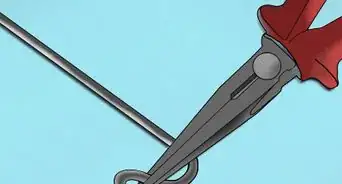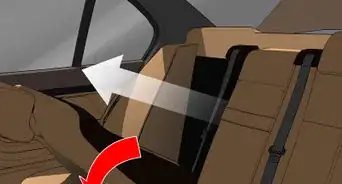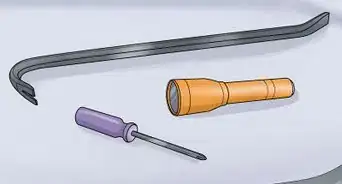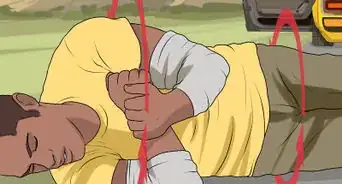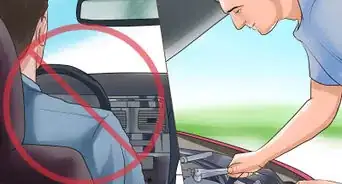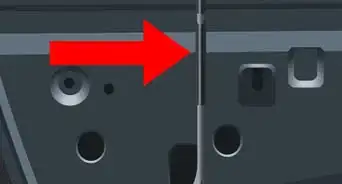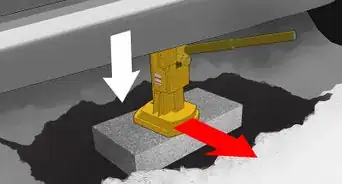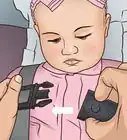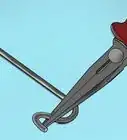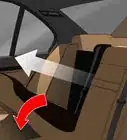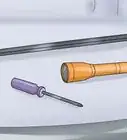wikiHow is a “wiki,” similar to Wikipedia, which means that many of our articles are co-written by multiple authors. To create this article, 10 people, some anonymous, worked to edit and improve it over time.
The wikiHow Video Team also followed the article's instructions and verified that they work.
This article has been viewed 347,907 times.
Learn more...
A wide variety of automotive tasks — from replacing brake pads to changing a flat — require you to lift up the car. Unless you have access to a full-size hydraulic lift like you might find at a mechanic's, this will mean using a jack. Jacks are generally easy to use, but care must be taken to ensure your safety, especially if you're working under the car. Luckily, this just means following a few common sense rules.
Steps
Taking Safety Precautions
If you can't meet these safety conditions or if you are unsure of how to proceed given your conditions, call for help.
-
1Park the car on a hard, flat surface. Having the car slip or roll off of the jack can be extremely dangerous to yourself and others. To prevent this, always work on a flat surface away from moving vehicles or distractions. The surface you work on should be hard and sturdy so that it will not shift or give way while you are working.[1]
- A concrete driveway or garage away from the road are good examples. A yard is a bad choice — even if it's flat, the dirt may not be strong enough to support the car.
-
2Chock the wheels. Chocks are wedge-shaped blocks made from metal and rubber that keep the wheels from rolling. Set a chock in front of each wheel at the opposite end of the car from where you intend to lift."[2]
- If you don't have chocks, some sources recommend bricks, cinder blocks, large rocks, or wedge-shaped pieces of wood.[3]
Advertisement -
3Double check that the car is parked. Set the parking brake and ensure the transmission is in "P." If the car has a manual transmission, put it in the lowest forward gear.
-
4In sub-par conditions, take extra precautions. As noted above, the instructions in this section are intended to protect yourself and others in the event the car slips off its jack. If you can't meet the conditions above but you absolutely must jack up the car, use the instructions below to make the process safer:
- If you must jack the car on a soft or broken surface such as a dirt shoulder, use a thick, flat piece of wood to make a stable platform for the jack.
- If you must jack the car on a slight incline, park next to the curb and turn the wheels into the curb so that they are touching it. This will prevent an out-of-control car from hurting others if it slips off the jack.
- Similarly, if you don't have anything to block the wheels with, turn the tires into the curb.[4]
- Never jack the car on the shoulder of a roadway. If you must jack the car somewhere near traffic, put on your hazard lights. If you have flares, cones, or pylons, use these to direct traffic away from you.
Raising the Car
-
1Find the jack point. Most vehicles have several points along the body where the vehicle is designed to be lifted. If you lift somewhere else, the car's own weight may cause damage to the frame (or, worse — cause it to slip off the jack). Luckily, the owner's manual will almost always tell you where a car's jack points are.[5]
- Typically, there is a jack point on each side behind the front wheels and in front of the back wheels. This will often be next to the rocker panels (the metal or plastic strips beneath the doors).
- Sometimes, there are two more central jack points located just behind the front and rear bumpers.
- If you're not sure where the jack points are, look for a flat metal area along the pinch weld (the weld running down the side of the car beneath the doors). There may also be a notch that matches the shape of the top of the jack, a cutout in the plastic skirt that exposes metal, or a sturdy plastic block attached to the frame. There may even be a spot labeled "jack" on the undercarriage.
-
2Position the jack under the jack point. Slide your jack underneath the jack point you just found. It doesn't need to be lined up perfectly — you will be able to slide it around until it is touching the car.
- Make sure the correct side is facing up. If the jack itself isn't labeled with a "this side up" warning, look in your owner's manual for visual instructions. Typically, the jack will have a wide, flat base and a smaller upward-facing arm with "teeth" at the edges pointing up into the body of the car.
-
3Raise the jack. The precise way to do this will depend on which type of jack you have (see below). As the upper arm of the jack nears the underside of the car, make last-minute adjustments as needed so that it lines up with the jack point.
- Scissor Jacks: These jacks look like two horizontal metal plates with a diamond-shaped mechanism in between. On one side of the jack is a metal hole connected to the main screw drive. Slip the included rod tool through the hole and turn to pull the sides of the jack inward and push the top and bottom of the jack apart. This lifts the vehicle.
- Hydraulic Jacks: Also called bottle or floor jacks. These look like metal base sections with a lever-like base extending to one side. There is a slot to slip the included rod tool into on one side. Crank the rod up and down in long, steady strokes to pump hydraulic fluid into the cylinder and raise the jack.
-
4Lift the car off of the ground. When the jack makes contact with the underside of the car, it will become harder to raise. Keep working the jack upward until you notice the corner of the car leave the ground. You can stop when the car has enough clearance for you to do your work. For common tasks like changing a tire, just a few inches is all that's necessary.
- Pay careful attention to any sound or movement while lifting the car. It is common to hear a 'pop' or a 'thud' as the jack shifts slightly. If this happens, check that it hasn't slipped out of position before continuing.
- Keep all parts of your body out from under the car at all times while lifting it. Though unlikely, serious injury or death can result if the car slips off the jack past this point.[6]
-
5If you will be working under the car, use jack stands. Work that requires you to put any part of your body under the car calls for jack stands. These offer a wider, more secure base for the car's weight than ordinary jacks. It is unsafe to work under the car without jack stands. See our jack stands article for detailed instructions. Typical use is as follows:
- Slip two jack stands underneath the car near where the jack is supporting it. Line the stands up with the pinch weld or jack point. Raise the jack stands until they are nearly touching the underside of the car. Lower the jack slowly and carefully until the jack stands "catch" the car.
- If you are not working under the car (for instance, if you are changing a tire), you can proceed without jack stands. Take care not to put any part of your body underneath the car as you work.
-
6Lower the car back down when finished. At this point, you are ready to do whatever work you need to do on your car. When you are done, gradually lower the car back to the ground, remove the jack, and put it away. If you are using jack stands, you must first raise the car off of the stands, then remove the stands, and finally lower the car. See below:
- Scissor Jacks: Slip the rod into the screw drive hole and turn in the opposite direction as you did to raise the car.
- Hydraulic Jacks: Open the relief valve to let fluid drain from the hydraulic cylinder, which lowers the arm. The valve is usually a small screw keyed to the lever. Take care to open the valve slowly to avoid suddenly dropping the car.
Community Q&A
-
QuestionCan I jack up an old car by the bumper?
 AcyclistTop AnswererNo, your bumper is not designed to take the weight of the car. There will be designated jack points you will be able to use to life the car with a jack.
AcyclistTop AnswererNo, your bumper is not designed to take the weight of the car. There will be designated jack points you will be able to use to life the car with a jack. -
QuestionSome cars come with a bumper jack. Are these safe?
 Logic Johnson LafontaineTop AnswererThey're no better or worse than any other jack, except they're only reliable on even ground. Same rules as always: be careful where you lift (don't actually try to jack your car just by the bumper) and do not ever get under the car unless you have some good jack stands to hold it up.
Logic Johnson LafontaineTop AnswererThey're no better or worse than any other jack, except they're only reliable on even ground. Same rules as always: be careful where you lift (don't actually try to jack your car just by the bumper) and do not ever get under the car unless you have some good jack stands to hold it up.
References
- ↑ https://www.ifixit.com/Guide/How+to+Jack+Up+a+Car+(or+Truck)/67013
- ↑ http://blog.uscargocontrol.com/basic-wheel-chock-use-and-safety-tips/
- ↑ http://www.dummies.com/how-to/content/how-to-safely-jack-up-your-vehicle.html
- ↑ http://www.dummies.com/how-to/content/how-to-safely-jack-up-your-vehicle.html
- ↑ https://www.digitaltrends.com/cars/how-to-jack-up-a-car/
- ↑ https://www.productsafety.gov.au/news/under-your-car-diy-vehicle-maintenance
About This Article
Before jacking up a car, park it on a hard, flat surface such as a level parking lot or driveway. Put chocks in front of both wheels on the opposite end of the car from where you intend to jack it up. If you don’t have chocks, you can use bricks or cinderblocks instead. Make sure the car is in Park before you start jacking it up. Look under the car for the closest jack point to the tire you want to raise up. These might look like flat metal pieces or notches on the underside of the car. Your owner’s manual should tell you where the jack points are located. Slide your jack under the jack point with the flat base facing down. Then, start raising the jack. The way you do this will depend on what kind of jack you have, but you may need to push a lever or turn a crank to raise it. Once the top of the jack makes contact with the bottom of the car, you’ll need to use more effort to keep raising it. Stop once the car is far enough off the ground for you to get access to whichever part you need to work on. If you need to be underneath the car, put two jack stands under the car near the jack for extra support in case the jack shifts or collapses. When you’re done with your work, raise the car up high enough so you can easily remove the jack stands, then slowly lower your car back to the ground and remove the jack. To find out how to use jack stands and what you should do in poor weather conditions, keep reading!
